The desire to create machines to replace human labor has been around since the invention of the wheel. After all, it’s human nature to try to create time- and money-saving efficiencies when and wherever possible. However, the excitement over novel technology often overshadows new downsides, including job losses.
Competing with AI Art
Just how good is computer-generated work—and is it a threat to the personalization and awards space?
By: Shon Roti
(Originally printed in the March/April 2023 issue of Insights.)
The desire to create machines to replace human labor has been around since the invention of the wheel. After all, it’s human nature to try to create time- and money-saving efficiencies when and wherever possible. However, the excitement over novel technology often overshadows new downsides, including job losses.
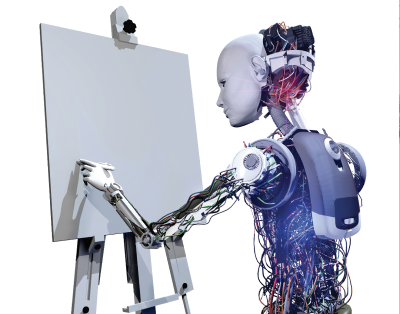
Maybe even less obvious is the loss of inspired human input. Some experts argue that new technologies can often create new jobs or that new technology removes mundane human tasks. I do believe there is at least some truth in both arguments—consider that much of the manufacturing industry has been automated (see inside any large auto plant to find robots along an assembly line that used to comprise auto workers).
Today, it’s the creative industry at stake. If you’d asked me 10 years ago if my profession as a graphic designer could ever be replaced by a robot, I would have rolled my eyes. Recent innovations in artificial intelligence have me questioning this position. Figure A represents several examples of AI-generated works by midjourney.com, a platform for text-to-art software.
It is impressive and a little scary. Midjourney, DALL-E and other AI entities use online data (photos, illustrations and other design works paired with text) to train software. Large-scale data mines like the Large-scale Artificial Intelligence Open Network (LAION) make it easier to find content that is scraped from publicly available images online. This technology can even mimic a particular artist if enough of the artist’s content exists online.
The text-to-art model relies on the user to plug in descriptive words for results. Recently, Jason Allen, a resident of Pueblo, Colorado, won first prize at the 2022 Colorado State Fair in the digital arts competition, according to Smithsonian magazine. In this instance, Allen spent many hours plugging in different words to generate over 900 renderings from midjourney.com. Allen chose a few, adjusted the images in Photoshop and then used Gigapixel to enhance the resolution. Although he did not technically break any rules, his win did generate negative buzz, resulting in the Colorado State Fair saying that they were going to review and potentially change submission requirements for future contests.
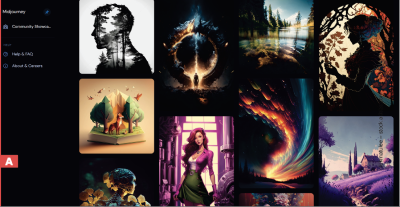
Figure A
Such recent developments have renewed the debate regarding what constitutes art. To be sure, AI has the potential to create new innovations, advance productivity and probably take ideas into directions not thought of before. It’s the nefarious side of technology that concerns many observers.

Figure B
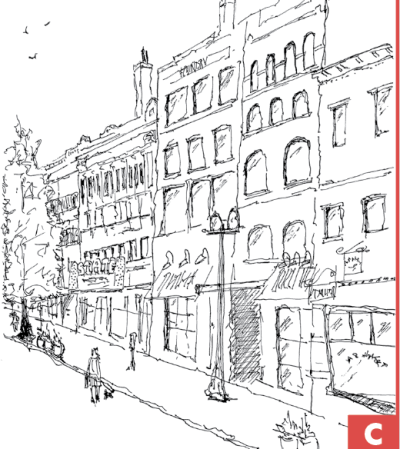
Figure C
Other questions come to mind, too. For instance, how will this affect our industry? Will this technology affect business models going forward?
Part of my business model relies on my ability to create new designs, including logos, T-shirts and infographics, for my clients. Those designs then appear on promotional products, which I’m happy to provide. The designs bring attention to my business and attract new clients. It’s my overall marketing strategy.
A Little Experiment
Using a photo I took several years ago (Figure B), I performed an experiment. I wanted to see how I could use AI to generate a sketch like the one I created by hand recently (Figure C). I did some research to find the best AI apps to turn photos into sketches and compare the results. I chose the free app iColorama S, which had good reviews. Downloading the app to creation of the final sketch took less than four minutes.
The app used my photo to create 26 different artistic options that included watercolor, graphite pens and colored pencils. I chose the option that looked closest to the pen and ink technique I use. The result can be seen in Figure D.
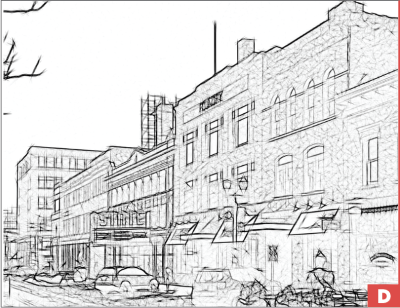
Figure D
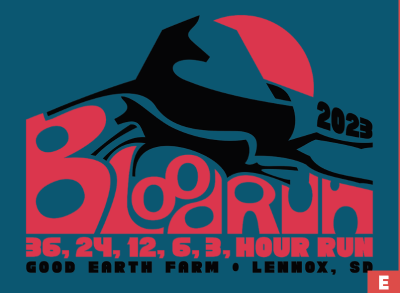
Figure E
It was almost too easy. Art is subjective, and although it lacked the randomness that I believe a human could provide, I thought it looked quite good, and the speed could never be matched by human hands. The resolution of the image was also good enough to print on a large canvas. I could have printed the “sketch” and had it hanging on the wall by the next day. Similar art effects can be found in Corel Photo-Paint, Photoshop and other image-manipulation software, as well.
It’s possible this text-to-art is a passing fad or the backlash over AI art may spur consumers to demand proof of originality and human creation over AI. But the danger of the artist being replaced still exists.
Local and Custom
All of this AI intrusion and easy access reminds me to double down on one of the assets that AI cannot have: true relationships with my clients and an understanding about the feelings they have about their businesses.
For instance, one of my clients hosts a run each fall where competitors get bragging rights (and custom-designed swag) for running a continued three-to 36-hour marathon at an organic farm in rural South Dakota. I know that their barn is a central focus at the farm, and I know the names of their pig and steer and the fact that an orphaned deer become a pet. All this familiarity allowed me to craft a custom T-shirt design that incorporates those ideas (Figure E).
I often visit with my clients about their business needs. Most live and do business within a 30-mile radius from me. Because I rely very little on online sales, my business is going to be less impacted by AI art.
Ultimately, it might be the traditional business philosophies that provide the best anti-AI defense:
- Know your clients and their businesses well.
- Tailor the work for the client.
- Be original.
- Avoid clichés and clip art.
Build relationships with real human input, responsiveness and custom designs and products.
Customers are more than a data point. They are more than a transaction. This is something AI will likely never understand.
Shon Roti is the owner of 9th Street Designs, a sublimation
and graphic design consulting and promotional products
business. A graphic designer, Shon has spent more than
two decades working as a production artist and instructor
in the awards and promotional products industry. In 2014,
the Awards and Personalization Association named him
Speaker of the Year. Contact him at shon@sublimationconsultant.com.
Join Today and Invest in Your Business
When you become a member of the Awards and Personalization Association, you will receive access to the print and online editions of Insights Magazine along with many other valuable benefits. Explore how we can help you get connected with industry experts, increase your skills and knowledge through relevant learning opportunities, and save money with discounts for your business.
LEARN MORE